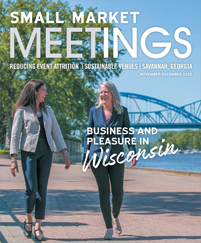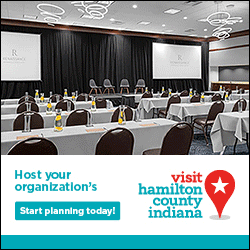Try these tips for reducing attendee attrition
The call of the sweatpants is compelling.
After years of remote work, tightened budgets and shifting priorities, workers are hesitant to forego comfort in favor of a convention attendance, and that is one of an event planner’s biggest challenges.
Even more concerning are the sky-high attrition rates. While the reasons behind this troubling trend may vary from changing attitudes to overbooked schedules, when attendees RSVP and then don’t show up, it interferes with venue contracts, disappoints clients and confounds an event’s bottom line. Here’s how three industry experts recommend fighting back against attendee attrition.
Reevaluate Your Event
Increased attrition forces planners to reevaluate the way they think about several event components.The first is pricing.
While growing costs and shrinking budgets are one reason people may choose not to come to events in the first place, that doesn’t mean the answer is to reduce price. It may seem counterintuitive, but free or low-cost events are the easiest for attendees to change their minds about.
“The higher the price tag, the more likely they are to show up,” said Vanessa Loney, owner and head of global planning at Blue Ribbon Events. “There’s more that’s been invested into the event, so you’re not going to get people who simply don’t show up if they’ve paid quite a bit.”
If the event is typically free, planners can consider adding a nominal fee, even if it’s just a small increase, to ramp up the attendee’s investment.
The second thing to reconsider is digital components to in-person events. Attrition for digital events is notoriously high, because despite good intentions, the stakes for not attending aren’t very compelling, especially if attendees can watch recorded sessions or download slide decks later.
If in-person numbers are important to the event, consider cutting the hybrid features. But if it’s a digital event, planners should offer an incentive to be there the day of.
“If we, as event professionals, want attendees to show up to these types of events, there has to be a value that the attendee can only get in real time,” said Mary Davidson, founder and event director of EP Events.
Turn Up the FOMO
Fear of missing out, or FOMO, drives a lot of decisions, and it can drive up event attendance, too. The first step to address this is to get to know the event’s target audience.
“You have to really do the research and understanding the attendee profile so that you can create thatFOMO experience,” said Loney.
This is true for both the event’s content and generating pre-event interest; if the conference is geared toward botanists, plant-themed trivia might be just the thing to engage the target audience and entice them to come.
Likewise, announcing speakers and content early can be a great hook for the event marketing.
“The sooner you can announce your full speaker lineup, the better, because then people can see the value in attending all those different sessions or breakouts,” said Jackie Baker, founder and CEO of Spark Events.
Planners should use cross-platform marketing to keep the event on their attendees’ minds early and often, whether that’s a countdown to the start day, a countdown of the number of tickets still available, or even a calendar embed feature on a digital invitation that lets attendees plug the event directly into their schedules.
“Having really strong communication with them helps people understand what will be happening at the event and makes them feel like they’ll be missing out if they’re not there,” Davidson said.
Advanced tech can also turn up the FOMO with features like social media integrations. Some registration pages offer the option to connect to an attendee’s LinkedIn network or even share that they’ll be attending.
“Those types of social media hooks work as well, because it gets the word out and adheres that person to attending the event, since they’ve already told everybody they’ll be there,” said Baker.
The Carrot Versus the Stick
Incentivizing attendees to show up for an event can be reinforced with either a carrot or a stick, depending on the industry or the company culture.
While many companies think of the event’s content as rewarding in and of itself, the rewards of attending must outweigh the many other priorities attendees have in their lives — or simply the inexplicable feeling of relief many people feel when cancelling plans.
One great reward to build into a program is the opportunity to feel a strong sense of community.“The real reason a lot of people go to events is networking, so we try to create really meaningful networking opportunities,” said Loney. “We have a lot of things that you can only get if you attend in-person. For example, we use an interactive mobile app that offers small group meetups within it to really create that community.”
Another way to increase the rewards of attending is with a bribe.
“Another thing is to have some credit for attendance,” said Davidson. “Maybe people get a gift when they come or some type of event money they can spend on site.”
Gifts, whether in the form of swag or even a raffle for a larger prize, can motivate attendees to followthrough and show up. Just make sure the gifts are selected with a lot of thought; no one needs another stress ball, but a high-quality insulated cup, a hilarious T-shirt or a unique tech gadget might excite attendees.
“It doesn’t matter what a big deal you think you are, everyone loves to get a gift,” said Baker. “It should be something that you have to be there to get.”
On the other hand, sometimes people are less likely to register and not show up if there’s some kind of consequence for doing so.
Cancellation policies can act as the proverbial stick. If refunds beyond a certain point are limited or simply unavailable, attendees might be more likely to prioritize showing up.
Another way to handle cancellations to give them the option for their cost to be credited toward a future event.If they’re unable to attend this year’s, at least they can attend in the future
Use Data as Feedback
While the days following the event may feel like a good time to breathe a sigh of relief, meeting planners know their job isn’t entirely done. This is the perfect time to collect and analyze the attendee data to evaluate what went well, what didn’t and what can be done better in the future. The same is true for attendance and attrition numbers.
Event data can help planners recognize trends and patterns in overall attendance, which can also help them source a venue of appropriate size, prepare adequately for catering needs and adjust their clients’ expectations for the event.
“It has absolutely been a game changer,” said Baker. “If you have an event where 1,000 people RSVP and only 600 people show up, that’s great data for the executive team to have year-over-year. You can’t make a budget just on vibes — you have to have the data to back up the vibes.”
Post-event communication with attendees is also a great way to lessen attrition for future events because it reminds them to register early.
“Something wonderful to do six months post-event is to send follow-up emails reminding them about what they experienced at the event so that they’re thinking about it again,” said Davidson. “Maybe they would be more likely to sign up a little bit sooner.”
Likewise, if they missed out on last year’s event, using photography from the event to induce FOMO in anticipation of next year’s event can put it on their radar and make them more likely not to skip out this time.












